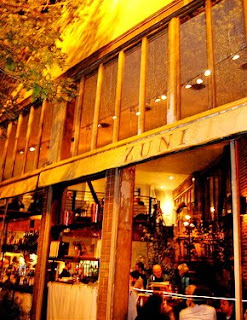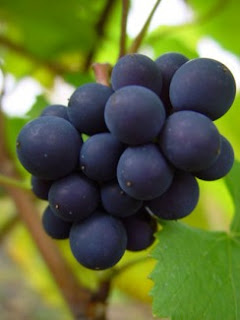 SAUVIGNON BLANC vs. RIESLING
SAUVIGNON BLANC vs. RIESLINGAlthough I do not fear low acid wines for food, there’s a lot to be said for crisply balanced, elevated acidity natural to varieties like sauvignon blanc and riesling.
In the mid-nineties I invited Peter Merriman, one of the founders of the Hawaiian Regional Cuisine movement, to prepare a meal for me in his style. Whether he’s aware of it or not, Peter’s own palate tends to veer on the acidic side. So his style of cooking was just the thing I was looking for:
- Quesadilla of Puna goat cheese, Kahuku shrimp & roasted macadamia nuts
- Fresh Sharwell avocado, pomelo & orange salad with watercress & arugula in fresh lime with honey
- Sesame crusted onaga (Hawaiian ruby, or red, snapper) with papaya relish, spicy mango sauce & organic Big Island greens
- Bonny Doon, “Pacific Rim” Riesling (Washington/California/Mosel)
- Cloudy Bay, Sauvignon Blanc (New Zealand)
What I didn’t predict, however, was how well both wines would do what they’re supposed to do, which is make a dish taste better than it would without wine. A classic example of how this works is French goat cheese (Chèvre) matched with Loire River style sauvignon blancs (such as Sancerre). Sharing common qualities of sharp acidity and somewhat earthy grassiness, Chèvre and Sancerre have long been considered one of the predictably best food and wine combinations in the world.
The goat cheese produced in the Big Island of Hawai`i, however, is a tad milder and less acidic than traditional Chèvres of France; something probably true about artisanal goat cheeses produced elsewhere in the U.S, from California to the Georgia. In the same fashion, the taste of Hawai`i’s Kahuku raised shrimp is somewhat milder than shrimp raised in most parts of the mainland U.S. So if it was just a mild dose of acidity and flavor that Merriman’s goat cheese and shrimp quesadilla needed, it certainly was found in the moderately crisp, fruity scented Bonny Doon riesling. But making an even more dynamic statement, the exuberantly zested, melony, citrusy and grassy qualities of the Cloudy Bay seemed to slice, dice and beg the palate to come back for bite after bite of shrimp and goat cheese in the quesadilla.
 In the second course, the dominant factors were the buttery avocado, the pomelo’s plump, pink grapefruity taste, and the slightly bitter edge of the greens. With the lime infused vinaigrette acting as a conduit, the riesling’s crisp, fragrant fruitiness did a neat job of balancing out the leafy, citrusy taste of the salad. But again, it was the more intensely flavorful Cloudy Bay that added an even more palate freshening dimension to this tropical style dish.
In the second course, the dominant factors were the buttery avocado, the pomelo’s plump, pink grapefruity taste, and the slightly bitter edge of the greens. With the lime infused vinaigrette acting as a conduit, the riesling’s crisp, fragrant fruitiness did a neat job of balancing out the leafy, citrusy taste of the salad. But again, it was the more intensely flavorful Cloudy Bay that added an even more palate freshening dimension to this tropical style dish.With the onaga – a meltingly soft, mild and lush white Hawaiian fish – Merriman snuck in a Malaysian chili spice into the mango sauce, and so this sweet/spice interplay as well as the crunchy fresh quality of the green beans all seemed to benefit equally by the steely edge of the riesling and the lavish, leafy greenery in the sauvignon blanc. Two wines, from two different grapes from different parts of the world, and both making these light, contemporary tropical island style dishes even fresher and livelier to the taste.
Some conclusions:
- Dishes utilizing vinaigrettes, citrusy (higher acid) fruits, chili spices, and slightly bitter edged mesclun and other greens could definitely benefit from higher acid varietals like riesling and sauvignon blanc (and maybe to a lesser extent, medium acid varieties like pinot gris, albarino and torrontès).
- Although one may be conditioned to reach immediately for authentic Loire River grown Sancerre or Pouilly-Fumé when dishing out a good Chèvre, you can also find a good match in any number of the world’s newer, crisp acid styles of sauvignon blanc, such as those of New Zealand and the West Coast of the U.S. – especially when goat cheese is used as a component in a dish with other ingredients.
- Dishes utilizing tropical fruit as a component, or in a relish or sauce, do particularly well with more highly perfumed, tropical fruit toned varieties – beginning with exuberantly fruity rieslings, and extending to the aromatic, fruit driven styles of sauvignon blancs from the New World.

THE IDEAL SAUVIGNON BLANC FOOD MATCHES
Observations specific to this extremely food versatile grape:
- Sauvignon blanc is a quintessential white wine calling for white meats (from fish and shellfish to chicken, pork or other-white-meats). Its typically crisp acidic edge and moderately medium weight does not lend itself to anything beyond that (it does not “cross over” into red meats).
- The crisp, lean taste profile of sauvignon blanc does not lend itself well to dishes containing disproportionate amounts of butter or cream (use only with balancing ingredients like lemon and capers, lest the wine turns unpleasantly sharp and the dish too fatty or oily). Exceptions: the rare cases when sauvignon blanc sees some barrel fermentation or oak aging (Robert Mondavi’s Reserve Fumé and Duckhorn’s Sauvignon Blanc from Napa Valley, Chalk Hill’s in Sonoma, and the sauvignon blanc dominated L’Ecole No. 41 Luminisce from Washington are some classic versions of the latter) does give you the opportunity to balance oily with tart sensations (like fish, chicken or veal in a the classic lemon caper butter sauce).
While the finest sauvignon blancs are replete with sweet melony (and sometimes citrusy, fig-like, and/or tropical mango/passionfruit) fruit qualities, its propensity towards nuances of green herbs, cut grass or weediness in the aroma and flavor make it a natural with dishes utilizing leafy green herbs (parsley, basil, chervil, and cilantro), and to a more limited extent, the more strongly scented herbs (rosemary, thyme, marjoram and oregano).
- By the same token, herb nuanced sauvignon blancs do well with dishes utilizing bell peppers (especially when roasted), olives, fennel, spinach, watercress, arugula, and most green leaf salad vegetables.
- Restrained (nota bene) use of aromatically similar chile peppers (most varieties) as well as chili spices, pastes and even curry mixes all stand to benefit from sauvignon blanc’s contrasting qualities of moderate alcohol, palate freshening acidity, and melony suggestions in the nose and flavor.
- Restrained use of lemon, citrus, pomegranate, tomatoes and other acid oriented fruits underscore sauvignon blanc’s natural acidic qualities.
- Besides Chèvre, other mildly acidic cheeses (Greek Feta, Le Banon from France, Cabrales from Spain, Pecorino from Italy, and extra sharp Cheddars) can work well with Sauvignon Blanc.
Feel free to grill or smoke, as this often brings out the minerally or flinty qualities of sauvignon blanc (especially those of France’s Loire River – Sancerre, Pouilly-Fumé, Quincy, Cheverny and Menetou-Salon).
- While sauvignon blancs are pretty much ideal for richer, fattier white meats (lobster, pork, whole chicken, etc.) with the use of complimenting ingredients, its moderately weighted, crisp quality makes it even more adept with lower fat seafoods or white meats (oysters, clams, flaky white fish, breasts of chicken, authentic veal, etc.).
- While sauvignon blanc is one of the few varieties that handily match mild vinegars (particularly winy balsamic, sherry and rice wine vinegars), these components still need to be used in balance with other complimenting, or contrasting, ingredients lest the match turns into an exercise in sourness (in the dish as well as wine).
- Since salt is more easily balanced by sweetness, don’t expect bone dry sauvignon blancs to work like a charm with highly salted or cured foods (although it can be done if a salty food component is balanced in the dish by specifically sauvignon blanc-friendly ingredients).
- For the same reason (the grape usually has tartness, not sweetness), use pickled vegetables with care in a dish.
- While sauvignon blanc is indeed a food versatile grape, it does not cross easily into the realm of Asian foods (use of ginger, star anise, shoyu, kaffir, ponzu, and disproportionate use of sugar, garlic, etc.). Better to leave that to more fragrant or aggressively spiced varieties (i.e. riesling and maybe viognier among whites, and pinot noir and syrah among reds).
Some of the more spot-on sauvignon blanc matches we have experienced over the years:
Crispy fried calamari with fennel, pasilla peppers, red onions and lemon aioli with a creamy, peachy, snappy Napa Valley sauvignon blanc by Source-Napa Gamble Vineyard at Cindy’s Backstreet Kitchen in St. Helena
- Deep yellow, deviled Biodynamic® eggs with fresh celery with a wildflowery fresh, lemony crisp yet silky Patianna Estate grown sauvignon blanc from Mendocino
- Lobster-sweetbread ravioli with morels in a truffled foamy broth with a fuller style, airy cream and tropical fruit scented Cade Sauvignon Blanc at Meadowood in Napa Valley
- Spring green salad with Chèvre and citrus in a caramelized bell pepper vinaigrette with a refined, stony scented Château Carbonnieux blanc (sauvignon blanc predominant white from France’s Graves in Bordeaux)
- Fresh snapper seviche with tequila, lime and roasted sweet peppers with a flinty, lemony zested Sancerre by Reverdy
- John Ash’s grilled marinated prawns with fresh melon salsa, matched with a light, mildly crisp and easy Lake County sauvignon blanc by Fetzer
- Quenelles of lobster, scallops and leeks in a shiitake shellfish consommé with a light, spring-fresh Frog’s Leap Sauvignon Blanc from Napa Valley
- Risotto of lobster and sea vegetables with English peas and asparagus with an intensely herbal, zesty New Zealand Sauvignon Blanc by Brancott
- Wood grilled Anaheim chile stuffed with shrimp, mint and red pepper couscous with a lush, vibrant, silky textured Sonoma grown sauvignon blanc by Matanzas CreekSpicy shrimp ravioli in a citrus achiote vinaigrette with a crisply balanced Ferrari-Carano Fumé Blanc
- Spicy shrimp ravioli in a citrus achiote vinaigrette with a crisply balanced Ferrari-Carano Fumé Blanc











Comments
Post a Comment